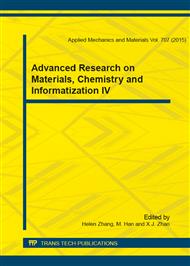p.3
p.7
p.12
p.16
p.20
p.24
p.28
p.32
The Effect of KNO3 on Electrolysis-Assisted Flocculation of Azophloxine Using Polyaluminum Chloride
Abstract:
Electrolysis-assisted flocculation methods were used in decoloration of azophloxine. Electrolysis-assisted flocculation of azophloxine was conducted under the applied potential using titanium anode. The concentration of KNO3, flocculating time and applied potential were investigated. The application of applied potential has nearly no power to remove the dye from wastewater since the highest decoloration rate is only 2.5% after treatment at KNO3 concentration of 0.6 mol/L. The total flocculating decoloration efficiency decreases gradually after increasing the KNO3 concentration in the solution. When the applied potential is 7 V, the maximum electrolysis-assisted flocculating decoloration rate is 52.3%. When the electrolysis-assisted flocculating time is 5 min, the maximum decoloration rate is 54.2%.
Info:
Periodical:
Pages:
3-6
Citation:
Online since:
December 2014
Authors:
Keywords:
Price:
Сopyright:
© 2015 Trans Tech Publications Ltd. All Rights Reserved
Share:
Citation:


